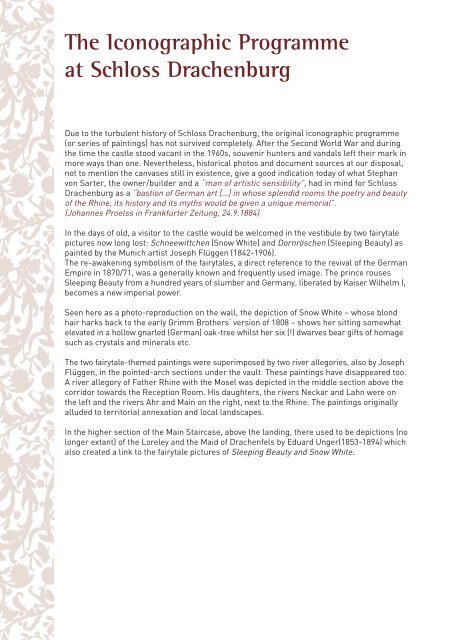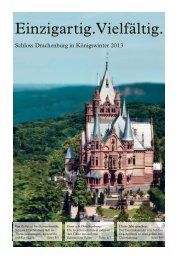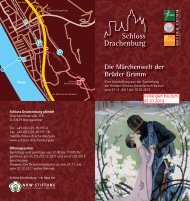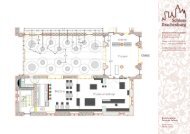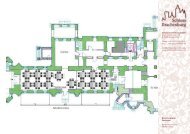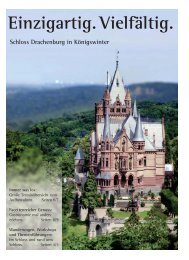North Tower - Schloss Drachenburg
North Tower - Schloss Drachenburg
North Tower - Schloss Drachenburg
You also want an ePaper? Increase the reach of your titles
YUMPU automatically turns print PDFs into web optimized ePapers that Google loves.
The Iconographic Programme<br />
at <strong>Schloss</strong> <strong>Drachenburg</strong><br />
Due to the turbulent history of <strong>Schloss</strong> <strong>Drachenburg</strong>, the original iconographic programme<br />
(or series of paintings) has not survived completely. After the Second World War and during<br />
the time the castle stood vacant in the 1960s, souvenir hunters and vandals left their mark in<br />
more ways than one. Nevertheless, historical photos and document sources at our disposal,<br />
not to mention the canvases still in existence, give a good indication today of what Stephan<br />
von Sarter, the owner/builder and a “man of artistic sensibility”, had in mind for <strong>Schloss</strong><br />
<strong>Drachenburg</strong> as a “bastion of German art […] in whose splendid rooms the poetry and beauty<br />
of the Rhine, its history and its myths would be given a unique memorial”.<br />
(Johannes Proelss in Frankfurter Zeitung, 24.9.1884)<br />
In the days of old, a visitor to the castle would be welcomed in the vestibule by two fairytale<br />
pictures now long lost: Schneewittchen (Snow White) and Dornröschen (Sleeping Beauty) as<br />
painted by the Munich artist Joseph Flüggen (1842-1906).<br />
The re-awakening symbolism of the fairytales, a direct reference to the revival of the German<br />
Empire in 1870/71, was a generally known and frequently used image. The prince rouses<br />
Sleeping Beauty from a hundred years of slumber and Germany, liberated by Kaiser Wilhelm I,<br />
becomes a new imperial power.<br />
Seen here as a photo-reproduction on the wall, the depiction of Snow White – whose blond<br />
hair harks back to the early Grimm Brothers‘ version of 1808 – shows her sitting somewhat<br />
elevated in a hollow gnarled (German) oak-tree whilst her six (!) dwarves bear gifts of homage<br />
such as crystals and minerals etc.<br />
The two fairytale-themed paintings were superimposed by two river allegories, also by Joseph<br />
Flüggen, in the pointed-arch sections under the vault. These paintings have disappeared too.<br />
A river allegory of Father Rhine with the Mosel was depicted in the middle section above the<br />
corridor towards the Reception Room. His daughters, the rivers Neckar and Lahn were on<br />
the left and the rivers Ahr and Main on the right, next to the Rhine. The paintings originally<br />
alluded to territorial annexation and local landscapes.<br />
In the higher section of the Main Staircase, above the landing, there used to be depictions (no<br />
longer extant) of the Loreley and the Maid of Drachenfels by Eduard Unger(1853-1894) which<br />
also created a link to the fairytale pictures of Sleeping Beauty and Snow White.


